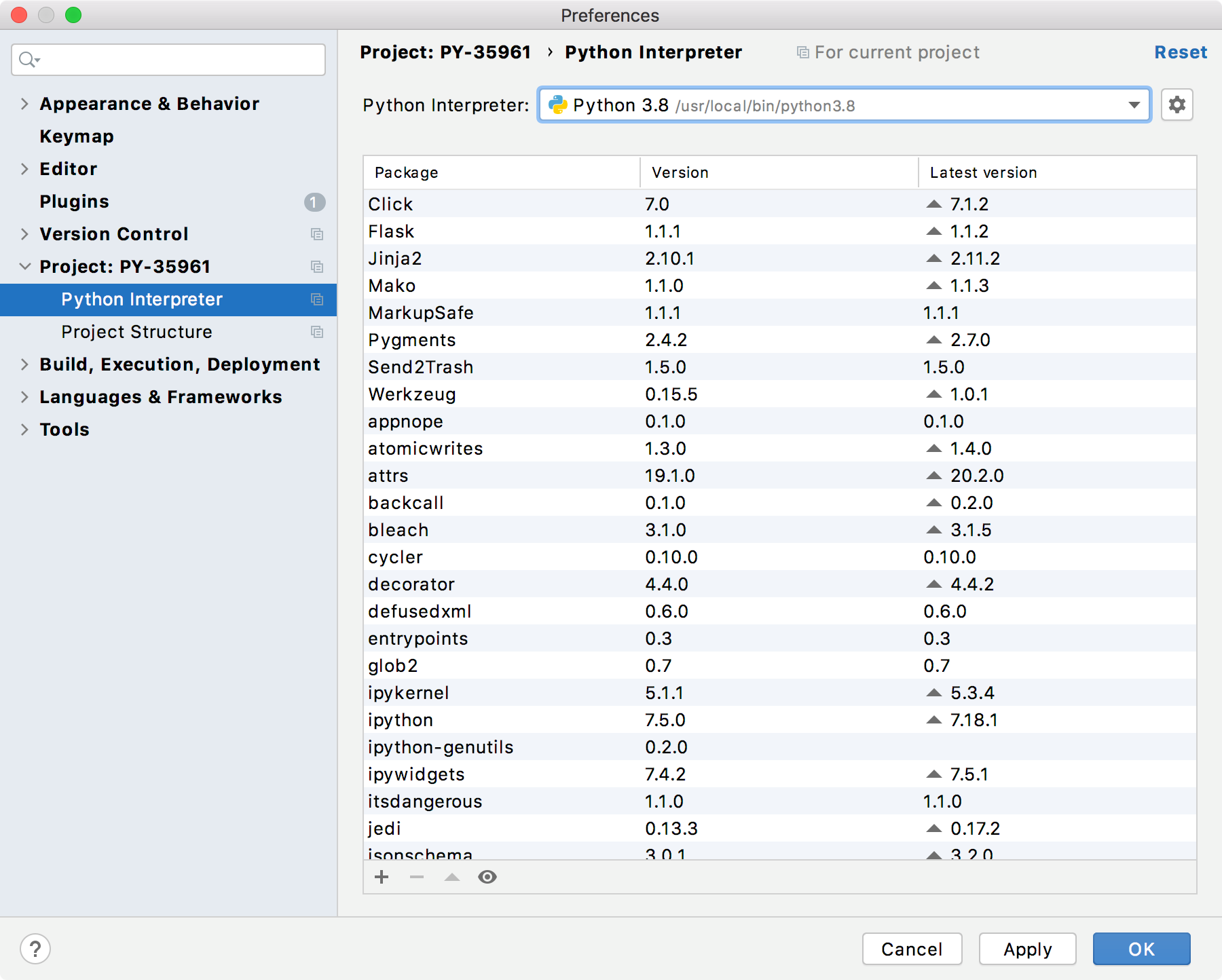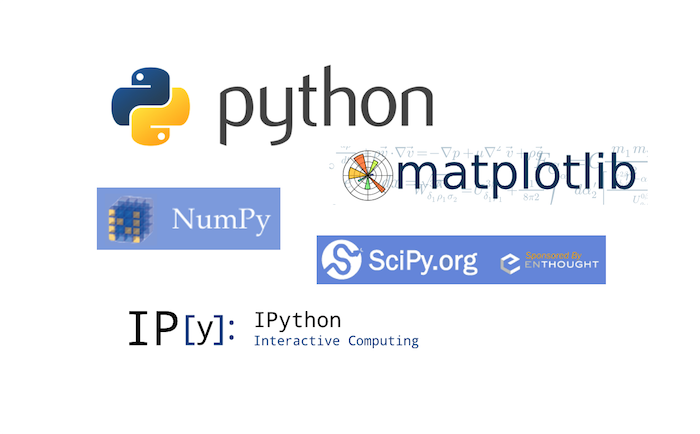Note that in order to avoid potential conflicts with other packages it is strongly recommended to use a virtual environment, e.g. Python3 virtualenv (see python3 virtualenv documentation) or conda environments. Using an isolated environment makes possible to install a specific version of scikit-learn and its dependencies independently of any previously installed Python packages. For most Unix systems, you must download and compile the source code. The same source code archive can also be used to build the Windows and Mac versions, and is the starting point for ports to all other platforms. Download the latest Python 3 and Python 2 source.
- IDE-python package. Feature Providers. Jedi for Completions, Definitions, Hover, References.
- Pillow is actually a fork of PIL – Python Image Library. At first, pillow was mainly based on.
Bob Savage <bobsavage@mac.com>
Python on a Macintosh running Mac OS X is in principle very similar to Python onany other Unix platform, but there are a number of additional features such asthe IDE and the Package Manager that are worth pointing out.
4.1. Getting and Installing MacPython¶
Mac OS X 10.8 comes with Python 2.7 pre-installed by Apple. If you wish, youare invited to install the most recent version of Python 3 from the Pythonwebsite (https://www.python.org). A current “universal binary” build of Python,which runs natively on the Mac’s new Intel and legacy PPC CPU’s, is availablethere.
What you get after installing is a number of things:
A
Python3.9folder in yourApplicationsfolder. In hereyou find IDLE, the development environment that is a standard part of officialPython distributions; and PythonLauncher, which handles double-clicking Pythonscripts from the Finder.A framework
/Library/Frameworks/Python.framework, which includes thePython executable and libraries. The installer adds this location to your shellpath. To uninstall MacPython, you can simply remove these three things. Asymlink to the Python executable is placed in /usr/local/bin/.
The Apple-provided build of Python is installed in/System/Library/Frameworks/Python.framework and /usr/bin/python,respectively. You should never modify or delete these, as they areApple-controlled and are used by Apple- or third-party software. Remember thatif you choose to install a newer Python version from python.org, you will havetwo different but functional Python installations on your computer, so it willbe important that your paths and usages are consistent with what you want to do.
IDLE includes a help menu that allows you to access Python documentation. If youare completely new to Python you should start reading the tutorial introductionin that document.
If you are familiar with Python on other Unix platforms you should read thesection on running Python scripts from the Unix shell.
4.1.1. How to run a Python script¶
Your best way to get started with Python on Mac OS X is through the IDLEintegrated development environment, see section The IDE and use the Help menuwhen the IDE is running.
If you want to run Python scripts from the Terminal window command line or fromthe Finder you first need an editor to create your script. Mac OS X comes with anumber of standard Unix command line editors, vim andemacs among them. If you want a more Mac-like editor,BBEdit or TextWrangler from Bare Bones Software (seehttp://www.barebones.com/products/bbedit/index.html) are good choices, as isTextMate (see https://macromates.com/). Other editors includeGvim (http://macvim-dev.github.io/macvim/) and Aquamacs(http://aquamacs.org/).

To run your script from the Terminal window you must make sure that/usr/local/bin is in your shell search path.
To run your script from the Finder you have two options:
Drag it to PythonLauncher
Select PythonLauncher as the default application to open yourscript (or any .py script) through the finder Info window and double-click it.PythonLauncher has various preferences to control how your script islaunched. Option-dragging allows you to change these for one invocation, or useits Preferences menu to change things globally.
4.1.2. Running scripts with a GUI¶
With older versions of Python, there is one Mac OS X quirk that you need to beaware of: programs that talk to the Aqua window manager (in other words,anything that has a GUI) need to be run in a special way. Use pythonwinstead of python to start such scripts.
With Python 3.9, you can use either python or pythonw.
4.1.3. Configuration¶
Python on OS X honors all standard Unix environment variables such asPYTHONPATH, but setting these variables for programs started from theFinder is non-standard as the Finder does not read your .profile or.cshrc at startup. You need to create a file~/.MacOSX/environment.plist. See Apple’s Technical Document QA1067 fordetails.
For more information on installation Python packages in MacPython, see sectionInstalling Additional Python Packages.
4.2. The IDE¶
MacPython ships with the standard IDLE development environment. A goodintroduction to using IDLE can be found athttp://www.hashcollision.org/hkn/python/idle_intro/index.html.
4.3. Installing Additional Python Packages¶
Mac Install Python
There are several methods to install additional Python packages:
Packages can be installed via the standard Python distutils mode (
pythonsetup.pyinstall).Many packages can also be installed via the setuptools extensionor pip wrapper, see https://pip.pypa.io/.
4.4. GUI Programming on the Mac¶
There are several options for building GUI applications on the Mac with Python.
PyObjC is a Python binding to Apple’s Objective-C/Cocoa framework, which isthe foundation of most modern Mac development. Information on PyObjC isavailable from https://pypi.org/project/pyobjc/.
The standard Python GUI toolkit is tkinter, based on the cross-platformTk toolkit (https://www.tcl.tk). An Aqua-native version of Tk is bundled with OSX by Apple, and the latest version can be downloaded and installed fromhttps://www.activestate.com; it can also be built from source.
wxPython is another popular cross-platform GUI toolkit that runs natively onMac OS X. Packages and documentation are available from https://www.wxpython.org.
PyQt is another popular cross-platform GUI toolkit that runs natively on MacOS X. More information can be found athttps://riverbankcomputing.com/software/pyqt/intro.
4.5. Distributing Python Applications on the Mac¶
The standard tool for deploying standalone Python applications on the Mac ispy2app. More information on installing and using py2app can be foundat http://undefined.org/python/#py2app.
4.6. Other Resources¶
The MacPython mailing list is an excellent support resource for Python users anddevelopers on the Mac:
Another useful resource is the MacPython wiki:
Greetings, Earthling! Welcome to The Hitchhiker’s Guide to Python.
This is a living, breathing guide. If you’d like to contribute,fork us on GitHub!
This handcrafted guide exists to provide both novice and expert Pythondevelopers a best practice handbook to the installation, configuration, andusage of Python on a daily basis.
This guide is opinionated in a way that is almost, but not quite, entirelyunlike Python’s official documentation. You won’t find a list of every Python web frameworkavailable here. Rather, you’ll find a nice concise list of highly recommendedoptions.
Note
The use of Python 3 is highly preferred over Python 2. Consider upgrading your applications and infrastructure if you find yourself still using Python 2 in production today. If you are using Python 3, congratulations — you are indeed a person of excellent taste.—Kenneth Reitz
Let’s get started! But first, let’s make sure you know where your towel is.
Getting Started with Python¶
New to Python? Let’s properly setup up your Python environment:
- Picking a Python Interpreter (3 vs 2)
- Properly Install Python on your system:
- Using Virtualenvs with Pipenv:
- Pipenv & Virtual Environments
- Lower level: virtualenv

Python Development Environments¶
This part of the guide focuses on the Python development environment,and the best-practice tools that are available for writing Python code.
- Your Development Environment
- Pipenv & Virtual Environments
- Lower level: virtualenv
- Further Configuration of pip and Virtualenv
Writing Great Python Code¶
This part of the guide focuses on the best-practices for writing Python code.

- Structuring Your Project
- Code Style
- Documentation
- Testing Your Code
- Logging
- Common Gotchas
Scenario Guide for Python Applications¶
This part of the guide focuses on tool and module advice based ondifferent scenarios.
- Network Applications
- Web Applications & Frameworks
- HTML Scraping
- Command-line Applications
- GUI Applications
- Databases
- Networking
- Systems Administration
- Continuous Integration
- Speed
- Scientific Applications
- Image Manipulation
- Data Serialization
- XML parsing
- JSON
- Cryptography
- Machine Learning
- Interfacing with C/C++ Libraries
Shipping Great Python Code¶
This part of the guide focuses on sharing and deploying your Python code.
- Publishing Your Code
- Packaging Your Code
- Freezing Your Code
Additional Notes¶

This part of the guide, which is mostly prose, begins with somebackground information about Python, and then focuses on next steps.
- Introduction
- The Community
- Learning Python
- Documentation
- News
Note
How To Install Packages In Python
Notes defined within all diatonic and chromatic musical scales have beenintentionally excluded from this list of additional notes. Additionally,this note.
Contribution notes and legal information (for those interested).
- Contribute
- The Guide Style Guide
